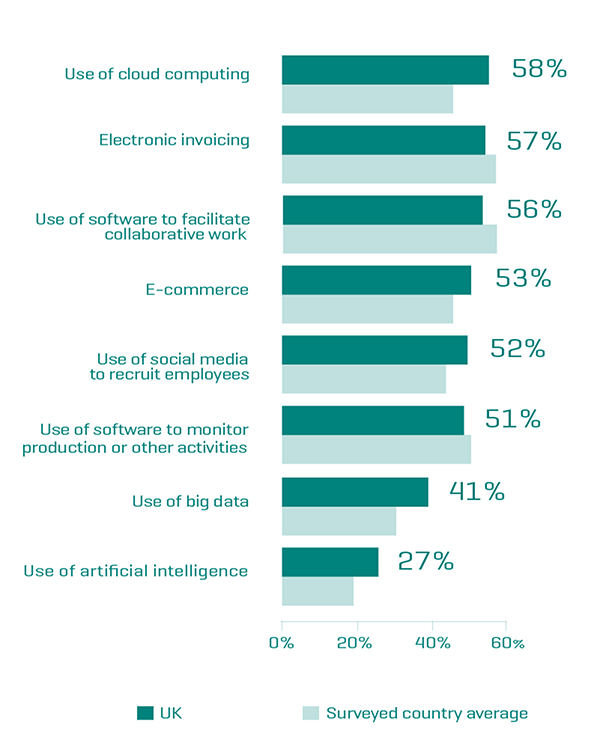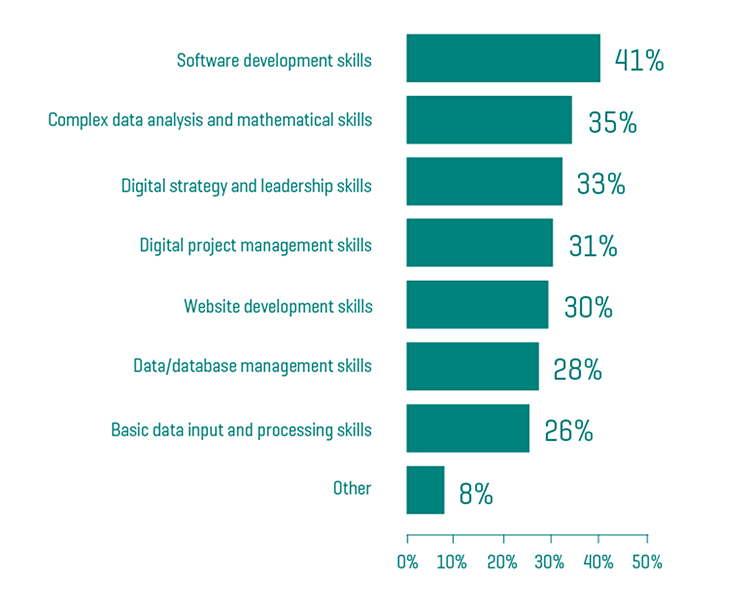
Digital skills are increasingly essential to a successful modern business, regardless of its size or number of employees. There has been a steady increase in the use of digital services by organisations in the past decade, both to reach customers and make day-to-day operations more efficient.
This has only accelerated during the COVID-19 pandemic, with many enterprises forced to close their physical shops or offices and rely almost exclusively on digital channels for business generation and communication.
Medium-sized operations – those with more than 50 employees – and large businesses were already well equipped to handle this situation, as they tend to employ a variety of IT specialists either in house or as contractors. However, this has been an extremely difficult adjustment period for small businesses.
Stagnation and skills gap
The then Department of Business, Innovation & Skills (DBIS) conducted a survey of SMEs in 2014 and published its findings the following year in a report entitled Digital capabilities in SMEs.
It found a positive link between digital skills and the growth of a business; however, it also reported that a quarter of SMEs said they did not possess basic digital skills, meaning they made little or no use of the internet, and had no web or social media presence. At the time the survey was conducted, this equated to 1.2m enterprises.
Significantly, the report noted that this issue was particularly acute in the construction sector; while 29% of SMEs in general did not have a website and had no plans to get one, the figure was 46% among construction SMEs. The report suggests that "the less digitally mature groups still don't understand the benefits of being online and therefore aren't as clear and as positive about how this can help their organisations to grow".
It also observed that although 64% of SMEs did have a website, the figure rose to 94% among medium-sized businesses. This indicates that a lack of digital skills and provisions was already disproportionately affecting smaller businesses, even in 2014. Unfortunately, numerous sources show that the figures have stagnated around these levels.
In 2017, the digital skills gap was estimated to be costing the UK economy £63bn in lost additional GDP per year. Of course, this is not solely attributable to SMEs, and includes productivity lost by less-skilled employees with all companies. But it does illustrate the massive costs at stake because of a lack of basic digital skills.
To put this figure in context, it is estimated that the COVID-19 pandemic could cost small businesses up to £69bn. The digital skills gap can therefore be considered on a par with a global pandemic every year in terms of losses to the UK economy.
Why do you need a website?
It may be that you have successfully maintained your business in your local area for years, or even decades. So why should you need a website now?
Businesses that do not have a website will find it hard to reach potential new customers who haven't already heard of them. While they can respond to visits or phone calls during the working day, they are not connected by internet searches that occur at home outside traditional business hours, which make up an ever-greater proportion of customer experiences. The pandemic has accelerated this trend, but the direction of business has only been one way for at least a decade now.
A 2019 report by website hosting company Wix found that 40% of UK businesses still have no online presence. According to a Visa study conducted in the same year, just 54% of UK SMEs sell their products and services online. While the latter figure is up from 2014, small businesses still make up the vast majority of the companies that are not trading online.
A shift to digital-first operation is no longer simply a nice addition for a business: the Wix survey "found that the businesses that are completely digital – using digital tools such as invoicing and payments, customer service, chat, and automations – saw their revenues increase by an average of £35,000 a month".
Some businesses may already have a website. All the same, they need to ensure that it works well on a mobile phone or tablet device. A 2019 report for social change charity the Good Things Foundation, Improving digital skills for small and micro businesses, states that "in the UK, 25m people prefer to shop through their mobile phone. However, only 18% of SMEs have optimised their services for mobile use." Notably, the report also states that 41% of sole traders fall into the category of low digital capability, emphasising the lack of growth in this area since the 2015 DBIS paper.
An increasing number of businesses are using social media pages so customers can make preliminary contact, which can be very effective. Social media provides an opportunity to talk with customers, advertise products or services and define your brand identity. It can also be particularly useful when preparing for networking events, allowing you to learn more about the participants beforehand and interact with people you can't necessarily see face to face during and afterwards. You can't get this level of interaction from a business website alone: you can increase your reach and profile by having a social media presence that encourages traffic to your site, and vice versa.
What does it mean to be digital?
Websites are just the most visible feature of a digital plan. A company that does not have a site is also unlikely to have adopted other, more complex digital tools such as e-commerce, analytics or big data, so an online presence is an easy if slightly reductive single measure of digitisation.
However, according to one 2019 report, Going Digital: The challenges facing European SMEs, to be considered digital a business should be engaged in at least three of the following activities:
- e-commerce
- electronic invoicing
- use of social media to recruit employees
- use of software to monitor the production or other activities of your company
- use of software such as Microsoft Teams, WhatsApp, Slack, Yammer to enable collaboration
- use of cloud computing
- use of big data
- use of artificial intelligence.
However, as Figure 1 shows, you may be able to gain a competitive advantage over many of your peers by exploring options such as e-commerce and productivity software, given that almost half of companies are not yet making use of these. Some tools, such as cloud computing, now come as standard with many types of Windows business licence so they can be easily added to your workflow. But there are steps that can be taken to ensure you use tools in a way that’s most efficient for you.

Other options such as big data and artificial intelligence may initially seem completely alien to your normal way of working, but with some guidance they could become useful. It is also important to remember that this software can have a multiplier effect – with well-integrated tools that talk to each other, you can combine e-commerce with an invoicing system and save records to the cloud, which can also be used to diarise appointments and access your stored data from any location. Establishing a digitisation strategy can save time and costs for you, your employees or other stakeholders.
The international context
Although the figures differ a little from country to country, the trend of SMEs struggling with their digital transition is reported almost everywhere. In the US, less than two-thirds of small businesses have a website. Similarly, German digital association Bitkom has estimated that domestic companies are losing around €10bn in revenues as a result of shortage of IT specialists.
The Going Digital report found that 71% of UK SMEs surveyed considered their business to be digitalised, leaving 29% that do not. Although the report noted that UK SMEs are slightly ahead of the other countries surveyed, there are still large skills gaps and a shortage of trained workers to fill them.
Lack of skilled staff
As previously reported in RICS Construction Journal, more than a quarter of working-age adults in England have either low literacy or low numeracy skills, or both. In 2020, 42% of European citizens were found to lack basic digital skills, and EU statistics directorate Eurostat has previously said more than half of EU enterprises reported difficulties filling positions that required relevant ICT skills.
Undoubtedly one of the largest issues facing SMEs that want to create a digital business is a lack of skilled staff either within the business or in the wider job market. Therefore, a business must either identify the skills needed to fulfil its strategy and train staff until there is no longer a skills gap, or find a way to stand apart from rivals and recruit IT professionals who are in short supply.

However, it is best not to start by assuming high levels of literacy and numeracy among your employees. This can be a difficult conversation to have with staff, so it is important to find ways of doing so in a positive and non-judgemental manner. Organisations such as the Literacy Trust or the Learning and Work Institute provide support to businesses to help improve literacy and numeracy skills.
Where next?
Taken as a whole, the situation may seem quite overwhelming, especially to the sole trader or micro business that doesn't have the budget, personnel, or time to make a total shift in its business plan. Buzzwords such as blockchain or cloud computing may make it feel as though your business is further behind than ever.
However, the good news is that there is a plethora of free or competitively priced educational resources, as well as a growing number of third-party companies that specialise in supporting digital transformation. Previously onerous and expensive tasks such as building a website have been massively simplified in the past few years, with companies such as Wix and Squarespace offering all the functionality needed without the burden of having to learn code.
In addition, small changes and improvements to the way a business operates can have significant consequences, especially for those companies that do not yet have a website or digital strategy. In the series of articles that follow, we will look at: how to develop a digital strategy; the educational tools available online; setting up a website from scratch on a budget with no previous knowledge; how to optimise your position in search engine results; and other steps that a company can take to reach customers, save money and secure their data.
Note that other resources are always available on the RICS small business hub, while RICS also offers specific support and guidance for SMEs in dealing with COVID-19.
